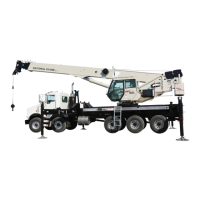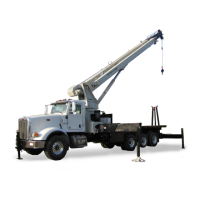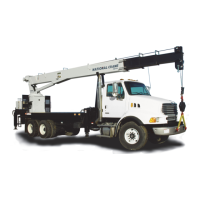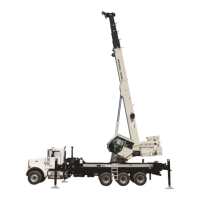National Crane 3-29-2018 Control # 610-00 4-23
NBT40-1 SERIES OPERATOR MANUAL OPERATING CONTROLS - CRANE
A lifting diagram is included for over-side, over-rear, and
over-front lifting areas. The lifting area diagram shows
locations of the outrigger jack cylinders in full extended
position are used to mark lifting area boundaries.
Another section contains notes for lifting capacities. Be sure
to read and understand all notes concerning lifting
capacities.
The load chart also gives weight reductions for load handling
devices such as hook blocks, overhaul balls, boom
extension sections, etc., which must be considered as part of
the load. Weight of any other load handling devices such as
chains, slings, or spreader bars must also be added to the
weight of the load.
NOTE: Information in the following paragraph is an
example only of how to compute a lift. Numbers
may not match load chart in the crane cab.
Example: A concrete beam weighing 2268 kg (5000 lb)
needs to be lifted to a height of 9.1 m (30 ft) at a radius of
15.2 m (50 ft) (maximum). The range diagram indicates the
boom must be extended to 18.9 m (62 ft) to reach a height of
9.1 m (30 ft) at a radius of 15.2 m (50 ft).
First check the crane for load handling devices. In our
example, the crane is equipped with a auxiliary boom nose
(rooster sheave) and a five ton overhaul ball. The rooster
sheave is 50 kg (110 lb), and the overhaul ball is 78 kg
(172 lb) for a total of 128 kg (282 lb). The lift requires slings
and spreader bars weighing 159 kg (350 lb) which makes
the total weight for the load handling devices 286 kg (632 lb).
A check of the load chart for a 15.2 m (50 ft) radius and
19.5 m (64 ft) of boom length shows a capacity of 3601 kg
(7940 lb) on outriggers over-front and 2254 kg (4970 lb) on
outriggers 360 degrees.
Subtract load handling weight of 632 lb from load capacity of
3601 kg (7940 lb) and 2254 kg (4970 lb). The result is a
weight capacity of 3315 kg (7308 lb) over-the-front and
1968 kg (4338 lb) for 360 degrees.
We are restricted in making the lift over-front only, with a
boom angle of about 29 degrees.
LIFTING THE LOAD
The following general guidelines outline proper procedure for
making a lift after crane has been properly set up.
1. Position crane in work area and set outriggers. See
Outrigger Setup, page 4-17 for outrigger setup.
2. Program RCL. Use load chart to estimate values.
3. Position boom nose over load. Do not try and drag load
with boom or hoist.
4. Perform lift. Meter controls when moving the load to
avoid sudden stops.
5. Retract and lower boom after lift is complete.
SHUT DOWN AND PREPARATION FOR
ROAD TRAVEL
1. Ensure swingaway, if so equipped, is properly stowed
and secured or removed from crane.
2. Retract and place boom in boom rest.
3. Ensure center front stabilizer is fully retracted, if
equipped. Ensure outrigger beams and jacks are fully
retracted with floats properly stowed.
4. Engage mechanical travel lock (if equipped) at each
outrigger beam.
5. Engage swing brake.
6. Engage swing lock.
7. Either hook block may be reeved over main boom nose
or headache ball may be reeved over main boom nose
or auxiliary boom nose; the other must be removed and
stowed securely before traveling. If hook block or
headache ball remains reeved on boom, it must be
secured at tie down on carrier provided for that purpose.
8. Secure hook block and anti-two-block (A2B) weight:
CAUTION
Disengage hydraulic pumps for extended traveling, cold
weather starting, or engine checks.
Check cold tire pressure prior to extended travel. Refer to
tire inflation on crane.
CAUTION
Machine Damage Hazard!
Do not travel with an empty hook in a position where it can
swing freely. Either remove the hook block and/or
headache ball from the hoist rope(s) and stow securely or
make sure the hook block or headache ball is properly
secured to the tie down provided for that purpose.
Fully retract the outrigger jacks and properly store the
floats.
DANGER
Do not travel with swingaway extended to prevent
damage to crane.
Failure to comply with these instructions may cause death
or serious injury.

